Charles E W Bean, Diaries, AWM38 3DRL 606/251/1 - 1915 - 1936 - Part 2

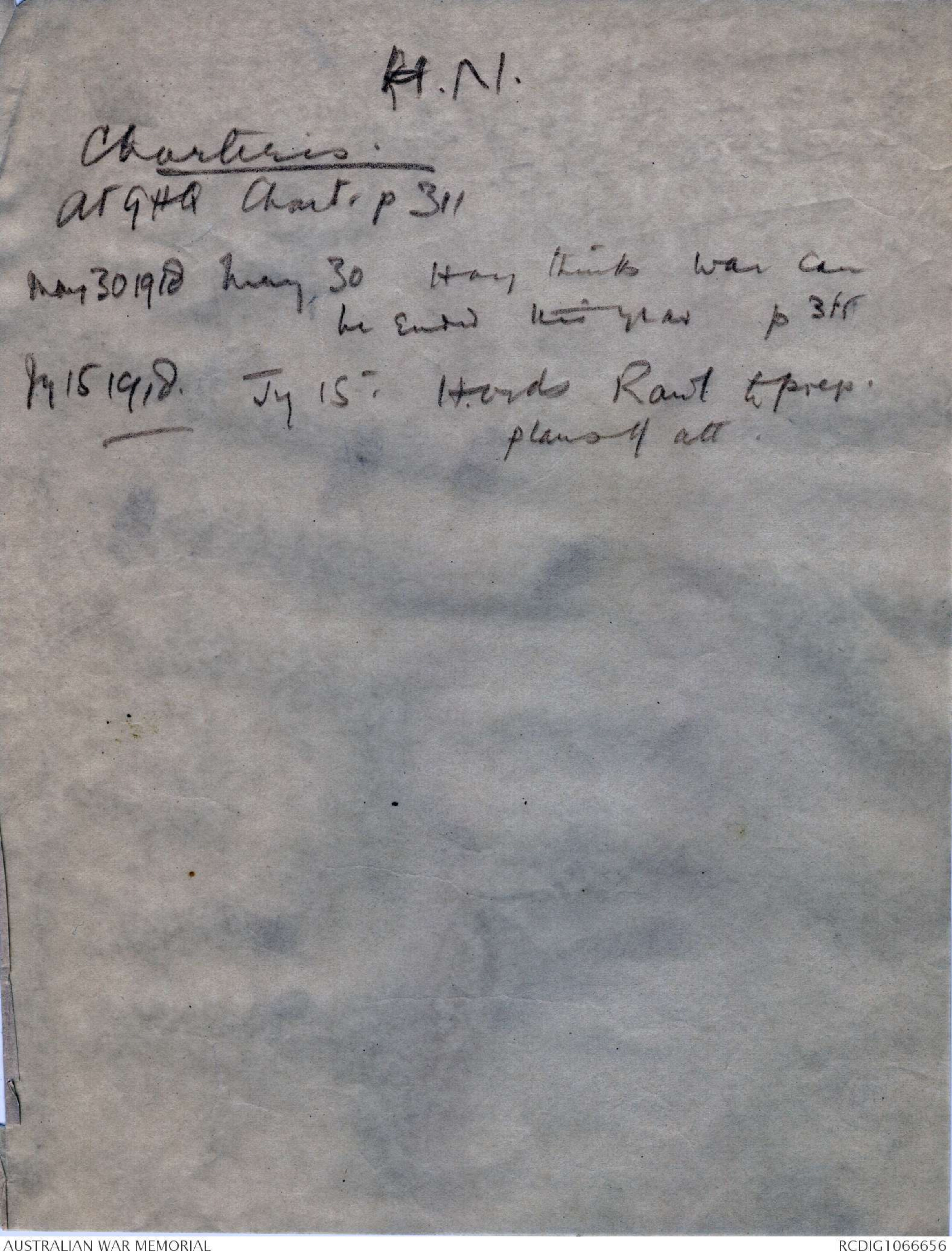
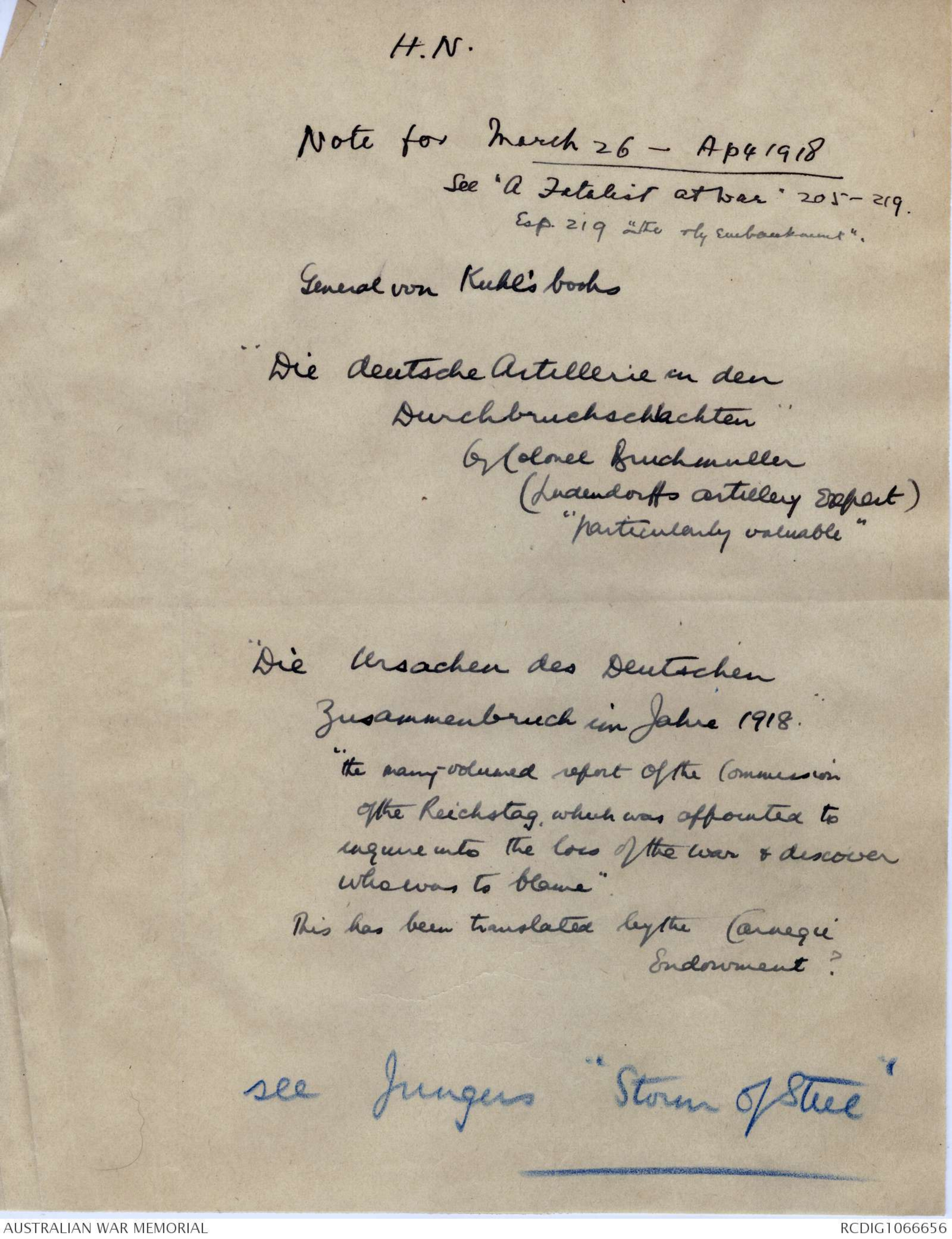
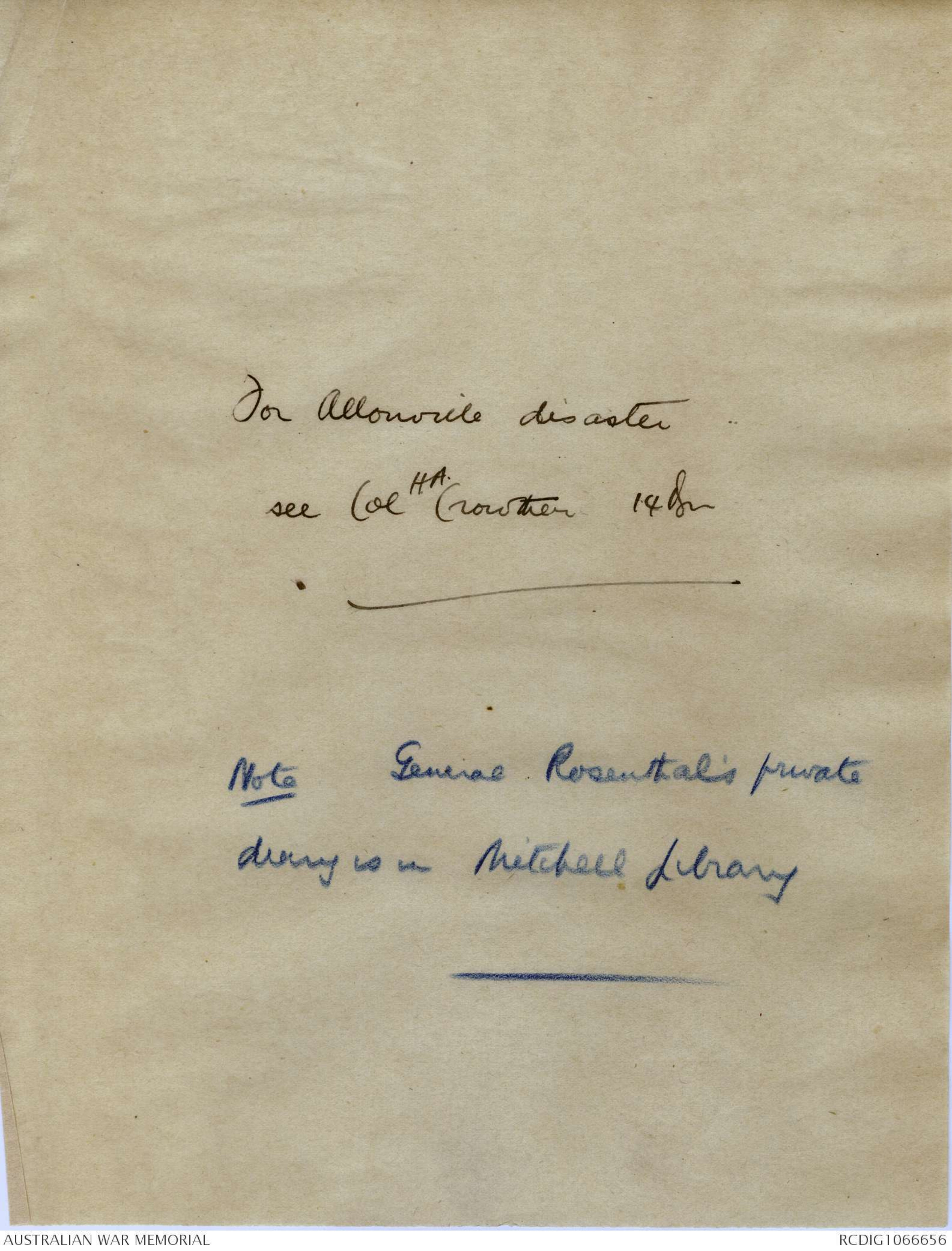
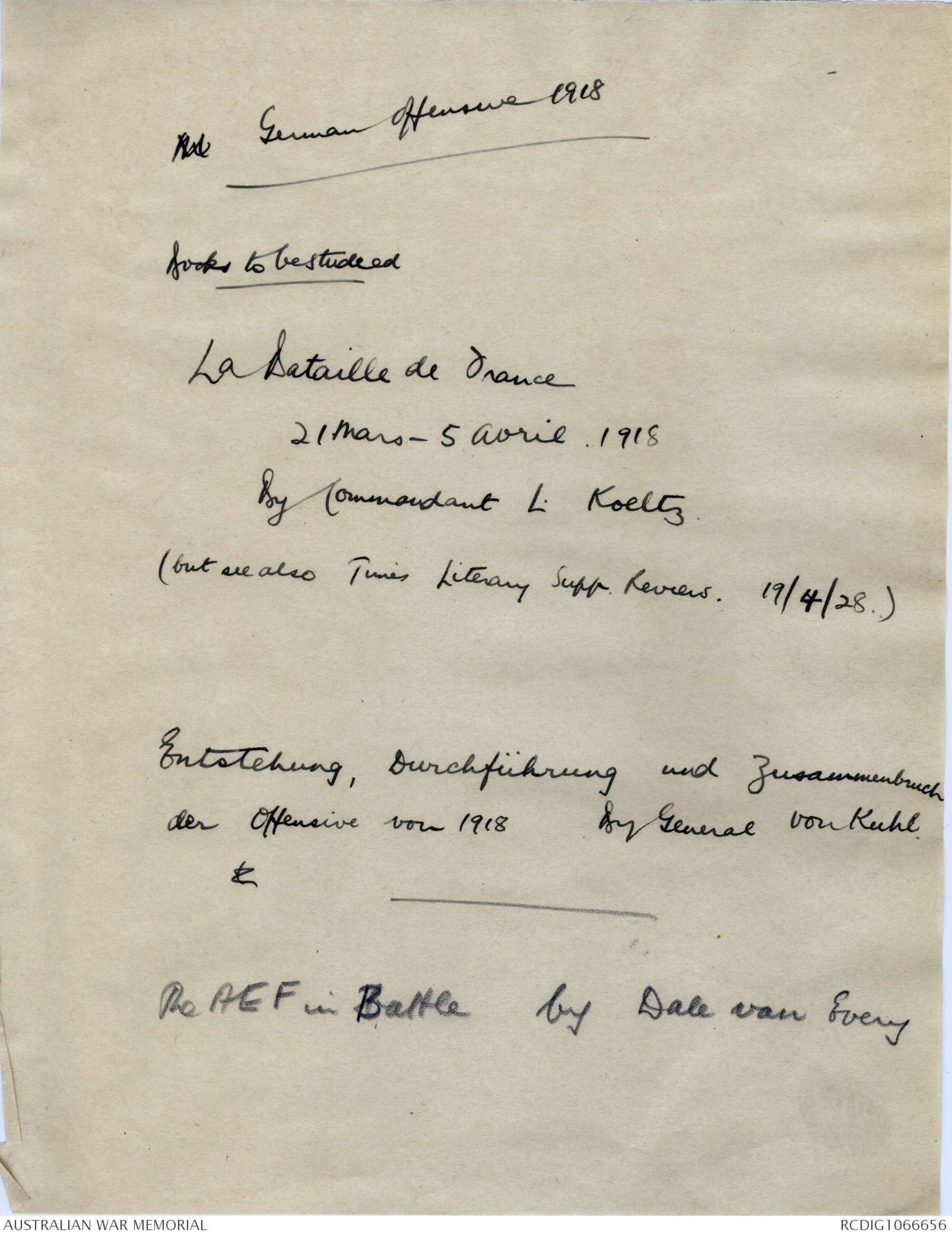


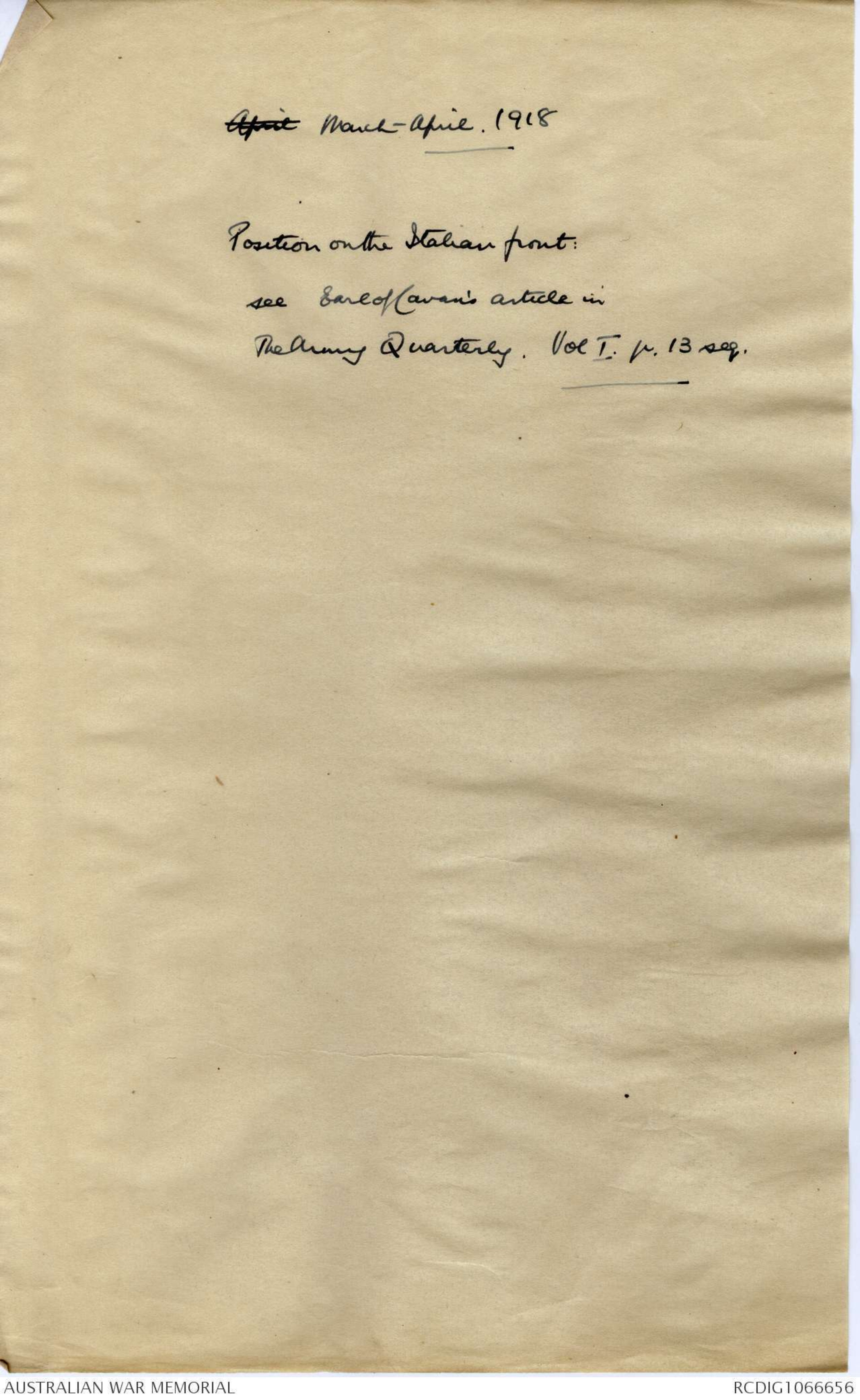
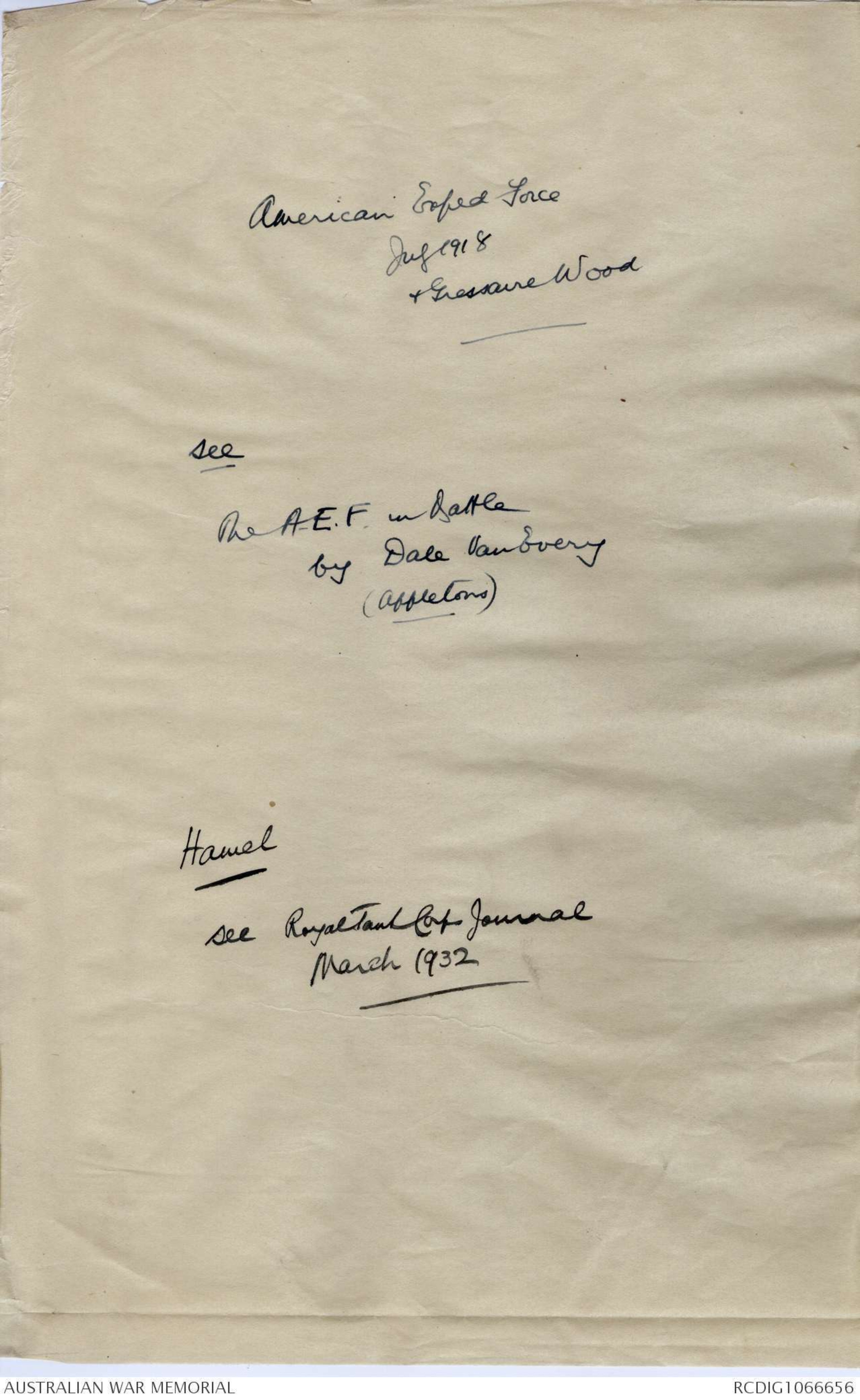
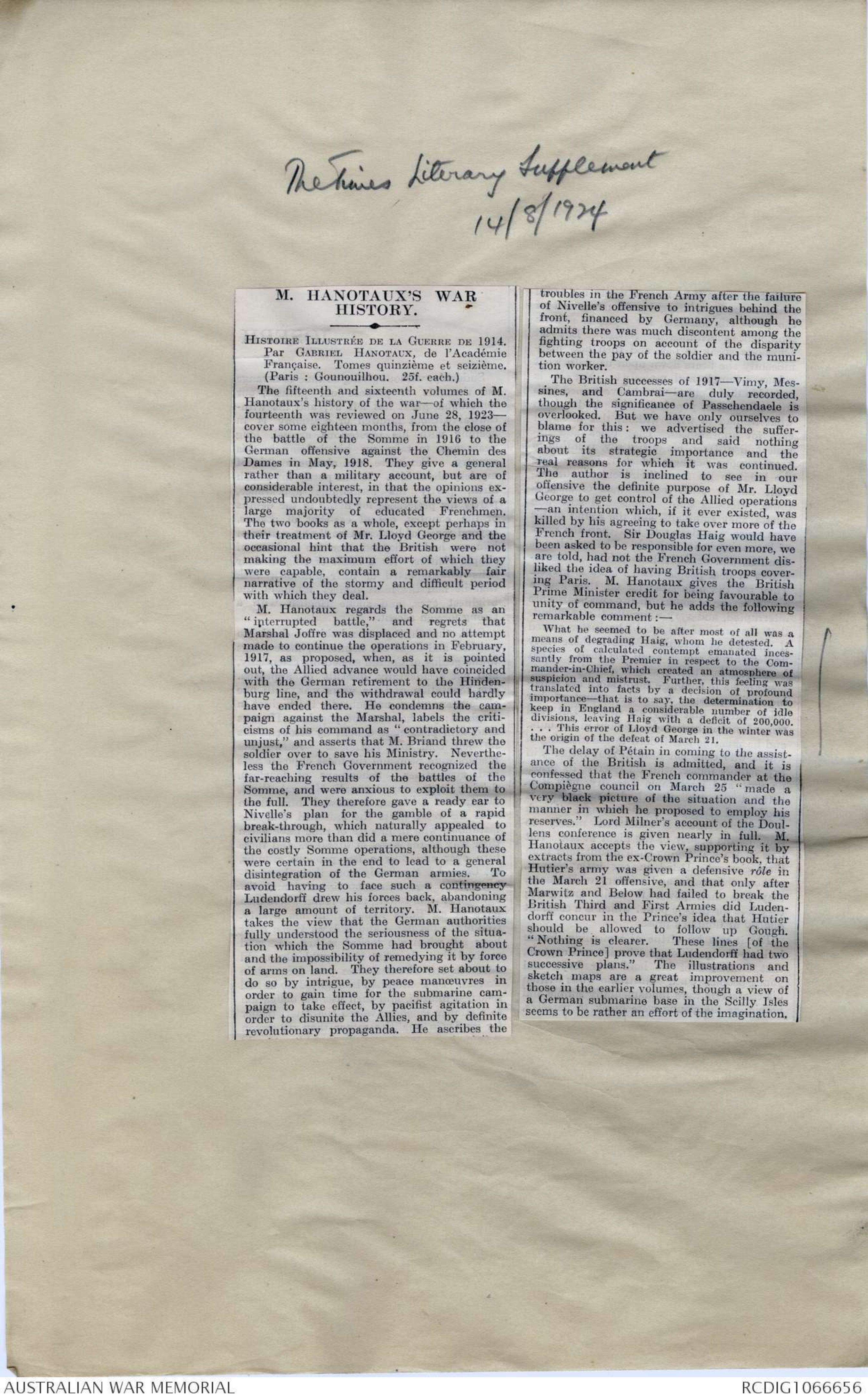
Reichstag Reports of the Reichstag Inquiry
into the Loss of the War & commentaries
written on the evidence by General von Kuhl
Colonel Schwertfeger & Prof Delbruck
See
L'Offensive Allemande de 1918
Commandant Koeltz
& Gen. Palat's volumes
Graf Schlieffen und der Weltkrieg
By Lt Col. Wolfang Foerster
La Strategie Allemande pendant
la Guerre de 1914-1918
Translated by Commandant Koeltz
is a translation of
Foerster's work abovementioned
H.N.
Charteris.
At GHQ Chart. p 311
May 30 1918 May 30 Hay thinks war can
be ended this year p 311
Jy 15 1918 Jy 15. Hords Rawl to prep.
plans if att.
H.N.
Note for March 26 - Ap 4 1918
See "A Fatalist at War" 205-219.
Esp. 219 "the rly embankment".
General von Kuhl's books
Die deutsche Artillerie en den
Durchbruchschlachten
by Colonel Buchmuller
(Ludendorffs artillery expert)
"particularly valuable"
Die Ursachen des Deutschen
Zusammenbruch in Jahre 1918.
"The many-volumed report of the Commission
of the Reichstag which was appointed to
inquire into the loss of the war & discover
who was to blame".
This has been translated by the Carnegie
Endowment?
see Jungers "Storm of Steel"
For Allonville disaster
see Col H.A. Crowther 14 Bn
Note General Rosenthal's private
diary is in Mitchell Library
Rd German Offensive 1918
Books to be studied
La Bataille de France
21 Mars - 5 Avril. 1918
By Commandant L. Koeltz.
(but see also Times Literary Supp. Review. 19/4/28.)
Entstehung, Durchführung und Zusammenbuch
der Offensive von 1918 By General von KuhlL
The AEF in Battle by Dale van Every
German Offensive 1918
see Nineteenth Century magazine
April 1918
Oct 1920
National Review Oct 1920 & Aug 1922
Cornhill Mag. Dec 1920
Repingtons "First World War"
Capt. P.E. Wright's Book.
Gen Maurice "The Last Four Months"
Army Quarterly Vol IX Article byx Col Piggott
The Fifth Army in March 1918 by W Shaw Sparrow
Also a book by ^containing diary or letters of Lt Braun (? son of the Socialist leader in Germany)
who was killed at V/Bret. An English translation has been published
March 1918
See Blackwoods Magazine, or his book
"Comments & Criticisms" by the Rt Hon Sir John Simon
for a description of Amiens in the grimmest
days of March 1918.
Also
Lord Birkenhead's
"Turning Points in History"
re Gough & Fifth Army
April March - April. 1918
Position on the Italian front:
see Earl of Cowan's article in
The Army Quarterly. Vol. I p. 13 seq.
American Exped Force
Aug 1918
& Gressaire Wood
see
The A.E.F. in Battle
by Dale Van Every
(Appletons)
Hamel
see Royal Tank Corps Journal
March 1932
The Times Literary Supplement
14/8/1924
M. HANOTAUX'S WAR
HISTORY.
HISTORIES ILLUSTRÉE DE LA GUERRE DE 1914.
Par GABRIEL HANOTAUX, de l'Académie
Française. Tomes quinziéme et seiziéme.
(Paris: Gounouilhou. 25f. each.)
The fifteenth and sixteenth volumes of M.
Hanotaux's history of the war - of which the
fourteenth was reviewed on June 28, 1923—
cover some eighteen months, from the close of
the battle of the Somme in 1916 to the
German offensive against the Chemin des
Dames in May, 1918. They give a general
rather than a military account, but are of
considerable interest, in that the opinions expressed
undoubtedly represent the views of a
large majority of educated Frenchmen.
The two books as a whole, except perhaps in
their treatment of Mr. Lloyd George and the
occasional hint that the British were not
making the maximum effort of which they
were capable, contain a remarkably fair
narrative of the stormy and difficult period
with which they deal.
M. Hanotaux regards the Somme as an
"interrupted battle", and regrets that
Marshal Joffre was displaced and no attempt
made to continue the operations in February,
1917, as proposed, when, as it is pointed
out, the Allied advance would have coincided
with the German retirement to the Hindenburg
line, and the withdrawal could hardly
have ended there. He condemns the campaign
against the Marshal, labels the criticisms
of his command as "contradictory and
unjust, " and asserts that M. Briand threw the
soldier over to save his Ministry. Nevertheless
the French Government recognized the
far-reaching results of the battles of the
Somme, and were anxious to exploit them to
the full. They therefore gave a ready ear to
Nivelle's plan for the gamble of a rapid
break-through, which naturally appealed to
civilians more than did a mere continuance of
the costly Somme operations, although these
were certain in the end to lead to a general
disintegration of the German armies. To
avoid having to face such a contingency
Ludendorff drew his forces back, abandoning
a large amount of territory. M. Hanotaux
takes the view that the German authorities
fully understood the seriousness of the situation
which the Somme had brought about
and the impossibility of remedying it by force
of arms on land. They therefore set about to
do so by intrigue, by peace manœuvres in
order to gain time for the submarine campaign
to take effect, by pacifist agitation in
order to disunite the Allies, and by definite
revolutionary propaganda. He ascribes the
troubles in the French Army after the failure
of Nivelle's offensive to intrigues behind the
front, financed by Germany, although he
admits there was much discontent among the
fighting troops on account of the disparity
between the pay of the soldier and munition
worker.
The British successes of 1917 - Vimy, Messines,
and Cambrai - are duly recorded,
though the significance of Passchendaele is
overlooked. But we have only ourselves to
blame for this: we advertised the sufferings
of the troops and said nothing
about its strategic importance and the
real reasons for which it was continued.
The author is inclined to see in our
offensive the definite purpose of Mr. Lloyd
George to get control of the Allied operations
-an intention which, if it ever existed, was
killed by his agreeing to take over more of the
French front. Sir Douglas Haig would have
been asked to be responsible for even more, we
are told, had not the French Government disliked
the idea of having British troops covering
Paris. M. Hanotaux gives the British
Prime Minister credit for being favourable to
unity of command, but he adds the following
remarkable comment:-
What he seemed to be after most of all was a
means of degrading Haig, whom he detested. A
species of calculated contempt emanated incessantly
from the Premier in respect to the Commander-in-Chief,
which created an atmosphere of
suspicion and mistrust. Further, this feeling was
translated into facts by a decision of profound
importance - that is to say, the determination to
keep in England a considerable number of idle
divisions, leaving Haig with a deficit of 200,000.
. . . This error of Lloyd George in the winter was
the origin of the defeat of March 21.
The delay of Pétain in coming to the assistance
of the British is admitted, and it is
confessed that the French commander at the
Compiègne council on March 25 "made a
very black picture of the situation and the
manner in which he proposed to employ his
reserves." Lord Milner's account of the Doullens
conference is given nearly in full. M.
Hanotaux accepts the view, supporting it by
extracts from the ex-Crown Prince's book, that
Hutier's army was given a defensive rôle in
the March 21 offensive, and that only after
Marwitz and Below had failed to break the
British Third and First Armies did Ludendorff
concur in the Prince's idea that Hutier
should be allowed to follow up Gough.
"Nothing is clearer. These lines [of the
Crown Prince] prove that Ludendorff had two
successive plans." The illustrations and
sketch maps are a great improvement on
those in the earlier volumes, though a view of
a German submarine base in the Scilly Isles
seems to be rather an effort of the imagination.
 Loretta Corbett
Loretta CorbettThis transcription item is now locked to you for editing. To release the lock either Save your changes or Cancel.
This lock will be automatically released after 60 minutes of inactivity.